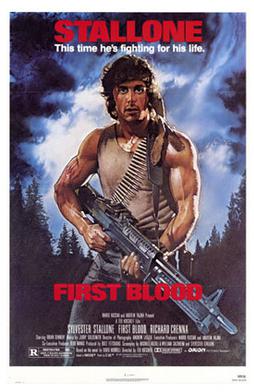
Theatrical release poster by Drew Struzan taken from Wikipedia
(7-6-20) I received a slew of emails about last week’s blog that called for shifting responsibility of the seriously mentally ill from the police to social service agencies and the medical community.
One long-time reader chastised me for unintentionally spreading a “cheap stereotype” of American soldiers when I wrote:
“No one wants RAMBO answering a mental health call.”
In a separate email, Virgil Stucker, who became president emeritus of the CooperRiis Healing Community in 2017 after serving as founding Executive Director from 2003, took issue with this statement:
“We have never shut down longer term treatment facilities. We simply have made them only available to individuals who can afford the high costs of such excellent facilities as McLean Hospital or such healing communities as Gould Farm or CooperRiis.”
Here’s what both had to say:
Dear Mr. Earley,
I’ve been an avid follow of your blog for quite some time now. Today I read your post: Defunding the Police and Serious Mental Illness: Opportunities, Hard Questions, Dangers. In the section entitled “Training Will Not Fix The Problem,” I read a line that bothered me quite a bit. You wrote “No one wants RAMBO answering a mental health call.” This single sentence has several problems.
To begin, I think you need to go watch First Blood, the movie that introduced cinema-goers to the character of John Rambo. In this film Rambo is a homeless veteran, depicted as suffering from what seems to be PTSD-like symptoms. He is walking across the country seeking out friends that he served with. The movie does end up becoming an 80’s action-fest, but only after Rambo is harassed, arrested, and brutalized by the local sheriff’s department. Rambo is not my enemy, he is me. Like me, he is a tortured soul suffering from mental illness. When his liberty is abused by local law enforcement he snaps and falls back on his special forces training. I am not trained as such, but I absolutely dread the idea of having an encounter with hostile law enforcement officers.
As a special forces soldier Rambo is trained for combat far and above what any Crisis Intervention Team trained officer would be. I spent my whole childhood around soldiers and have had the honor to train in various martial arts with some. My experience in talking with the soldiers in my family, or in my dojo, tells me that they not only know how to fight, but more importantly they know when to. And when not to. This is something that seems to be lacking in many encounters between law enforcement and so many people. Even during his escape he tries to reason with the Sheriff and his men because a man died falling out of a helicopter and Rambo did not want that death, or any more. He was answered with a hail of gunfire…
I would take John Rambo every day of the week and twice on Sundays. Not only is he far better trained than any regular cop, he is compassionate, uses force only as a last resort, and most importantly he knows a bit of what I experience every day.
Sure, I know what you were trying to say by invoking his name. That said, I think you made a mistake. Not only did you miss the mark on the actual story of John Rambo, but you also used a cheap stereotype of soldiers. As someone who spends a lot of time fighting stigma and stereotypes, you should have done better.
(name withheld for privacy.)
CooperRiis and the Cost of Residential Care
Virgil Stucker and his wife Lis have integrated their lives with therapeutic communities since they met in 1975 at Gould Farm.
Dear Pete,
I wanted to give you more information about the expenses that families may incur when they choose to use either CooperRiis or Gould Farm. I should also mention I am not speaking officially for either of them and I have no official connection with either of them. However, as you know, I have had something to do with each of them as well as a few other therapeutic communities. 
Also, residential therapeutic communities are generally not the better option if someone is already engaged in a lifestyle that includes a sense of belonging, relationships, and forward movement in regards to having and pursuing a sense of purpose and meaning. Someone in this situation is likely served better by a more robust, local outpatient set of services, which can help them increase their resilience and capacity to both deepen their sense of belonging as well as move more fully toward a greater sense of purpose and meaning.
For those who are more stuck or who need a more robust “college like” recovery experience, the therapeutic residential community may in fact be the better option.
So, let’s consider the cost of these places. Therapeutic communities first of all rely upon building a milieu that is healthy for those who become residents. In addition to the staffing that is needed to build a milieu, these communities also integrate varying levels of clinical staffing giving them an ability to deal with higher levels of acuity and complexity. CooperRiis has a more robust clinical team than Gould Farm and this is the reason for the difference in price between them.
(Please note that my remarks are based on my past experience with CooperRiis and Gould Farm and are not meant to be official or current observations.)
Each makes an effort to offer the highest quality of care and sets it’s top rate based on what families of more significant financial means are willing and able to pay. For those families who cannot afford the top rate, each offers rate reductions. You may not be aware of this, but if Gould Farm believes it can be of help, it offers rate reductions matched to the family’s ability to pay, generally from day one.
CooperRiis generally asks families to pay the full rate for two months and then offers rate reductions.
During my last year at CooperRiis, three years ago, we offered 3 1/2 million dollars in rate reductions on an annual budget of about $12 million.
There’s an interesting phenomenon that occurs; for both CooperRiis and Gould Farm it has been my past observation that their overall “collection rate“ is about 60% of the total asking price. By keeping a utilization level of about 85%, this ends up meaning that the expense budget can be covered by annual fundraising of about 5 to 10% of the budget. Also, I believe in both cases about half of the families who are served do receive rate reductions. The staff providing the care never know who pays what. Everyone gets the same high quality care and treatment.
All of the therapeutic communities I have been involved with have been nonprofits, meaning that none of the revenue goes into the pockets of shareholders. Also, this gives them two avenues for revenue, both earned revenue, the amount is paid by families, and donated revenue, the amount that is provided by donors.
Thankfully, as well, given the recent successes with class action suits in California, we’re finding that residential treatment centers like CooperRiis and Gould Farm are increasingly covered for sometimes 3 to 5 months by medical insurance.
I understand that the top price for places like CooperRiis or Gould Farm appear to be unaffordable to most families. However, if you look more closely you can see that each is designed for much broader financial access.
Ultimately, it is a model of care for some individuals that can truly help them achieve and sustain much higher levels of recovery. It is also an economically efficient model which I wish could be supported by public funding. Perhaps that day will sometime come.
Virgil Stucker, Therapeutic Consultant
www.VirgilStuckerandAssociates.com 828-388-4673
(As always, I welcome your comments on my Facebook page.)



